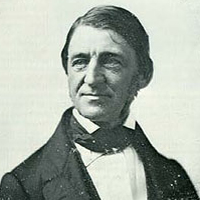The Snow Storm by Ralph Waldo Emerson: Summary and Analysis
The Snow Storm is one of the most noted poems of Emerson because it implicitly states his philosophy of the transcendental spirit in the nature. This poem describes very succinctly how the nature’s creative force leaves an amazing architectural landscape in just a night’s playful work. The snowstorm constructs wonderful structures that civilizations of human endeavor have not been able to achieve.

Ralph W. Emerson (1803-1882)
At a purely narrative level the poem describes an ordinary New England overnight snowstorm augmented by drifting winds. But Emerson’s storm is the arrival and passing of a great impersonal artist, hidden and working with materials from an “unseen quarry” to possess and transfigure the landscape.
The poem begins by describing the arrival of the snowstorm. It is described in the terms of a victorious march, as if it were an army ‘driving over the field’. But the very third line tells us that it is not only the physical and literal snowstorm, but also the manifestation of the creative spirit of the nature, that has arrived: “seems nowhere to alight”. And the ‘whited’ air hides hills and woods, rivers and heaven, and veils the farmhouse. In this there is a suggestion of the superiority of the nature even over what the heaven symbolizes. The onset of the poem conveys breathless speed, but then as the snow itself delays actions, the movement of the verse also slows down.
Emerson develops the doctrines of organic form. "The Snow-Storm", is usually read as a dramatization of the creative power of nature. What the snow does next is to hinder the people from going on with their normal course of life. The sled and traveler stopped, the postman’s feet are delayed, and all friends are shut out.
In the second stanza, the speaker is so exalted that he calls everyone to go see the amazing work of the storm, rather than be terrorized by the potentially fatal force of the nature. He describes the snow in terms of artistry, specifically the works of the mason. It is an invisible force partly manifested in the white air that is constructing the wonderful shapes, challenging the human beings’ achievements. It also makes these structures by taking out the materials out of an ‘unseen’ quarry (stone mine). The storm appears to be constructing a creating a great work of art in one evening. The snow is a creative force that leaves behind magnificent works of art of those who observe, but it is also a destructive force for those who misled by its ability to disuse. We need to be able to see beyond the illusions the snowstorm creates in order to be illuminated rather than blinded. The person in the best position to do this is the poet. On the symbolic/ allegorical level of the poem, Emerson is arguing of the best kind of poetry, which the true poet adapts from merely copying it. The jargon of masonry substantiates the imagery of the construction project of the snowstorm on the simple level of the poem’s meaning; but it underscores the irony that human masons can never construct structures (or art) that is so beautiful, so varied, so fascinating, and moreover so quickly and effortlessly. This is also a serious commentary on the limitations of the human art; so, human beings must try as much as they can to imitate the nature’s way of creation. The snowstorm furthermore works ‘mockingly’, pouring over and hiding the things that men have made, and this is symbolical too. And finally, when the entire world is his own, the invisible artist retries, without the pride typical of human artists: it retires as if “he were not”. He leaves when the sun appears. Here the sun symbolizes the reason, rationality and the like, for the artist is not always compatible with them, The “frolic architecture of the snow” is amazing to the observer, who is a poet aspiring to create such amazing works of art.
Cite this Page!
Shrestha, Roma. "The Snow Storm by Ralph Waldo Emerson: Summary and Analysis." BachelorandMaster, 16 Nov. 2013, bachelorandmaster.com/britishandamericanpoetry/the-snow-storm.html.
Related Topics
Ode Inscribed to W.H. Channing: Analysis
Ralph Waldo Emerson: Biography
 |
bachelorandmaster.com |